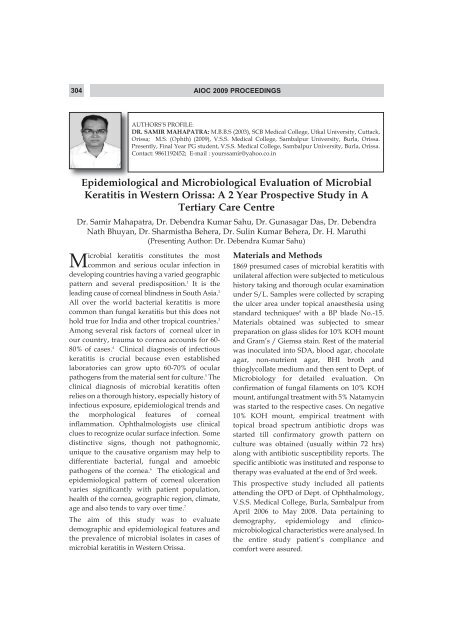inflamation session - All India Ophthalmological Society
inflamation session - All India Ophthalmological Society
inflamation session - All India Ophthalmological Society
Create successful ePaper yourself
Turn your PDF publications into a flip-book with our unique Google optimized e-Paper software.
304 AIOC 2009 PROCEEDINGSAUTHORS’S PROFILE:DR. SAMIR MAHAPATRA: M.B.B.S (2003), SCB Medical College, Utkal University, Cuttack,Orissa; M.S. (Ophth) (2009), V.S.S. Medical College, Sambalpur University, Burla, Orissa.Presently, Final Year PG student, V.S.S. Medical College, Sambalpur University, Burla, Orissa.Contact: 9861192452; E-mail : yourssamir@yahoo.co.inEpidemiological and Microbiological Evaluation of MicrobialKeratitis in Western Orissa: A 2 Year Prospective Study in ATertiary Care CentreDr. Samir Mahapatra, Dr. Debendra Kumar Sahu, Dr. Gunasagar Das, Dr. DebendraNath Bhuyan, Dr. Sharmistha Behera, Dr. Sulin Kumar Behera, Dr. H. Maruthi(Presenting Author: Dr. Debendra Kumar Sahu)Microbial keratitis constitutes the mostcommon and serious ocular infection indeveloping countries having a varied geographicpattern and several predisposition. 1 It is theleading cause of corneal blindness in South Asia. 2<strong>All</strong> over the world bacterial keratitis is morecommon than fungal keratitis but this does nothold true for <strong>India</strong> and other tropical countries. 3Among several risk factors of corneal ulcer inour country, trauma to cornea accounts for 60-80% of cases. 4 Clinical diagnosis of infectiouskeratitis is crucial because even establishedlaboratories can grow upto 60-70% of ocularpathogens from the material sent for culture. 5 Theclinical diagnosis of microbial keratitis oftenrelies on a thorough history, especially history ofinfectious exposure, epidemiological trends andthe morphological features of cornealinflammation. Ophthalmologists use clinicalclues to recognize ocular surface infection. Somedistinctive signs, though not pathognomic,unique to the causative organism may help todifferentiate bacterial, fungal and amoebicpathogens of the cornea. 6 The etiological andepidemiological pattern of corneal ulcerationvaries significantly with patient population,health of the cornea, geographic region, climate,age and also tends to vary over time. 7The aim of this study was to evaluatedemographic and epidemiological features andthe prevalence of microbial isolates in cases ofmicrobial keratitis in Western Orissa.Materials and Methods1869 presumed cases of microbial keratitis withunilateral affection were subjected to meticuloushistory taking and thorough ocular examinationunder S/L. Samples were collected by scrapingthe ulcer area under topical anaesthesia usingstandard techniques 8 with a BP blade No.-15.Materials obtained was subjected to smearpreparation on glass slides for 10% KOH mountand Gram’s / Giemsa stain. Rest of the materialwas inoculated into SDA, blood agar, chocolateagar, non-nutrient agar, BHI broth andthioglycollate medium and then sent to Dept. ofMicrobiology for detailed evaluation. Onconfirmation of fungal filaments on 10% KOHmount, antifungal treatment with 5% Natamycinwas started to the respective cases. On negative10% KOH mount, empirical treatment withtopical broad spectrum antibiotic drops wasstarted till confirmatory growth pattern onculture was obtained (usually within 72 hrs)along with antibiotic susceptibility reports. Thespecific antibiotic was instituted and response totherapy was evaluated at the end of 3rd week.This prospective study included all patientsattending the OPD of Dept. of Ophthalmology,V.S.S. Medical College, Burla, Sambalpur fromApril 2006 to May 2008. Data pertaining todemography, epidemiology and clinicomicrobiologicalcharacteristics were analysed. Inthe entire study patient’s compliance andcomfort were assured.
















